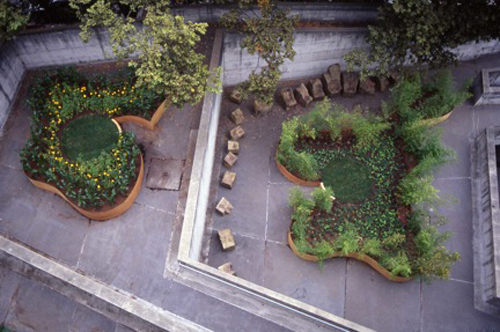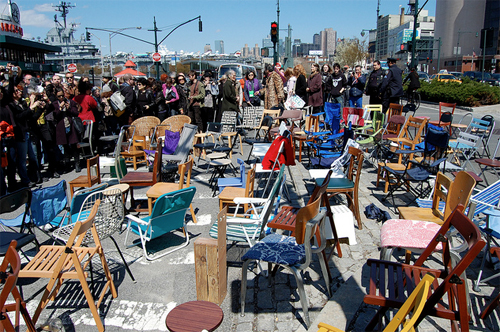I recently read an article by UC Berkeley Professor Michael Pollan about global warming and the seeming futility of our efforts to avoid a collective decline into a world without many things, including snow. He asked, "Why bother?" Why bother to turn off the lights, recycle, eat local, fill in your blank. His question was obviously rhetorical, but it nevertheless prompted me to reflect on some of the things I care about in this world, and some of the things I do in it, regardless of their significance or long-term impact.
 Tobias Rehberger: Sunny-side up August 29-November 14, 1999. MATRIX 180. Installation view from University of California Berkeley Art Museum. Curated by Heidi Zuckerman Jacobson. Image courtesy of the author.
Tobias Rehberger: Sunny-side up August 29-November 14, 1999. MATRIX 180. Installation view from University of California Berkeley Art Museum. Curated by Heidi Zuckerman Jacobson. Image courtesy of the author.
In art museums we struggle to quantify the success of our programs. The traditional evaluative method of "people in seats" -- otherwise referenced as bottom-line attendance numbers -- often falls short because what we do has the ability to have a bigger, more profound, and lifelong impact on visitors. The experience of a great work of art is something we return to -- both wittingly and unwittingly -- time and again. And those thoughts, feelings, and responses often do not occur until one has had the time to think about, talk about, or reflect on the object. Therein lies the excitement about the power of art and art museums.
In my years as a curator of contemporary art, the question I have most frequently been asked is how I make the choices I make, how and why I select the artists that I do. The best answer I have is that I show work about which I cannot stop thinking. It also has to somehow surprise me, maybe make me laugh or feel uncomfortable, usually be beautiful, and always be unexpected. But ultimately the primary criterion is that I want to spend more time with it, getting to know it better, because I am curious about it.
David Wojnarowicz
:
Paris/Normandy Journal
, 1979. David Wojnarowicz Papers, Fales Library, NYU. Image courtesy of the estate of the artist and Fales Library.
I have learned that oftentimes artists make art not because they want to but rather because they have to. The path is often unclear and sometimes lonely. Recently Chinese artist and activist Ai Weiwei said, "over the past three years, during all the efforts I have made, sometimes I felt like I was crying alone in a dark tunnel." Similarly, in a journal kept between 1972 and 1992, artist and activist David Wojnarowicz wrote, "I am shouting my invisible words." Making art is what these artists care/d about and do/did, and fortunately their impact on our culture has been significant. Showing art is what I care about and what I do. While the long-term impact is still to be determined and assessed, there is one thing of which I am certain: it is essential that those of us who value the ability of art to ignite thought continue to bother.
Ai Weiwei
:
Fairytale, 2007. 1001 Chinese visitors, 1001 Qing Dynasty wooden chairs.
Installation view. Image courtesy of the artist and Galerie Urs Meile, Beijing-Lucerne; Erlenmeyer Stiftung Switzerland; and Leister Foundation, Switzerland.
"
1001 Chairs for Ai Weiwei"
protest action on April 17, 2011, in front of the Chinese Embassy in New York City. Photograph by Christopher Kissock. Image courtesy Creative Time.
Our 2024 Coverage Needs You
It's Another Trump-Biden Showdown — And We Need Your Help
The Future Of Democracy Is At Stake
Our 2024 Coverage Needs You
Your Loyalty Means The World To Us
As Americans head to the polls in 2024, the very future of our country is at stake. At HuffPost, we believe that a free press is critical to creating well-informed voters. That's why our journalism is free for everyone, even though other newsrooms retreat behind expensive paywalls.
Our journalists will continue to cover the twists and turns during this historic presidential election. With your help, we'll bring you hard-hitting investigations, well-researched analysis and timely takes you can't find elsewhere. Reporting in this current political climate is a responsibility we do not take lightly, and we thank you for your support.
Contribute as little as $2 to keep our news free for all.
Can't afford to donate? Support HuffPost by creating a free account and log in while you read.
The 2024 election is heating up, and women's rights, health care, voting rights, and the very future of democracy are all at stake. Donald Trump will face Joe Biden in the most consequential vote of our time. And HuffPost will be there, covering every twist and turn. America's future hangs in the balance. Would you consider contributing to support our journalism and keep it free for all during this critical season?
HuffPost believes news should be accessible to everyone, regardless of their ability to pay for it. We rely on readers like you to help fund our work. Any contribution you can make — even as little as $2 — goes directly toward supporting the impactful journalism that we will continue to produce this year. Thank you for being part of our story.
Can't afford to donate? Support HuffPost by creating a free account and log in while you read.
It's official: Donald Trump will face Joe Biden this fall in the presidential election. As we face the most consequential presidential election of our time, HuffPost is committed to bringing you up-to-date, accurate news about the 2024 race. While other outlets have retreated behind paywalls, you can trust our news will stay free.
But we can't do it without your help. Reader funding is one of the key ways we support our newsroom. Would you consider making a donation to help fund our news during this critical time? Your contributions are vital to supporting a free press.
Contribute as little as $2 to keep our journalism free and accessible to all.
Can't afford to donate? Support HuffPost by creating a free account and log in while you read.
As Americans head to the polls in 2024, the very future of our country is at stake. At HuffPost, we believe that a free press is critical to creating well-informed voters. That's why our journalism is free for everyone, even though other newsrooms retreat behind expensive paywalls.
Our journalists will continue to cover the twists and turns during this historic presidential election. With your help, we'll bring you hard-hitting investigations, well-researched analysis and timely takes you can't find elsewhere. Reporting in this current political climate is a responsibility we do not take lightly, and we thank you for your support.
Contribute as little as $2 to keep our news free for all.
Can't afford to donate? Support HuffPost by creating a free account and log in while you read.
Dear HuffPost Reader
Thank you for your past contribution to HuffPost. We are sincerely grateful for readers like you who help us ensure that we can keep our journalism free for everyone.
The stakes are high this year, and our 2024 coverage could use continued support. Would you consider becoming a regular HuffPost contributor?
Dear HuffPost Reader
Thank you for your past contribution to HuffPost. We are sincerely grateful for readers like you who help us ensure that we can keep our journalism free for everyone.
The stakes are high this year, and our 2024 coverage could use continued support. If circumstances have changed since you last contributed, we hope you'll consider contributing to HuffPost once more.
Already contributed? Log in to hide these messages.
 Tobias Rehberger: Sunny-side up August 29-November 14, 1999. MATRIX 180. Installation view from University of California Berkeley Art Museum. Curated by Heidi Zuckerman Jacobson. Image courtesy of the author.
Tobias Rehberger: Sunny-side up August 29-November 14, 1999. MATRIX 180. Installation view from University of California Berkeley Art Museum. Curated by Heidi Zuckerman Jacobson. Image courtesy of the author.